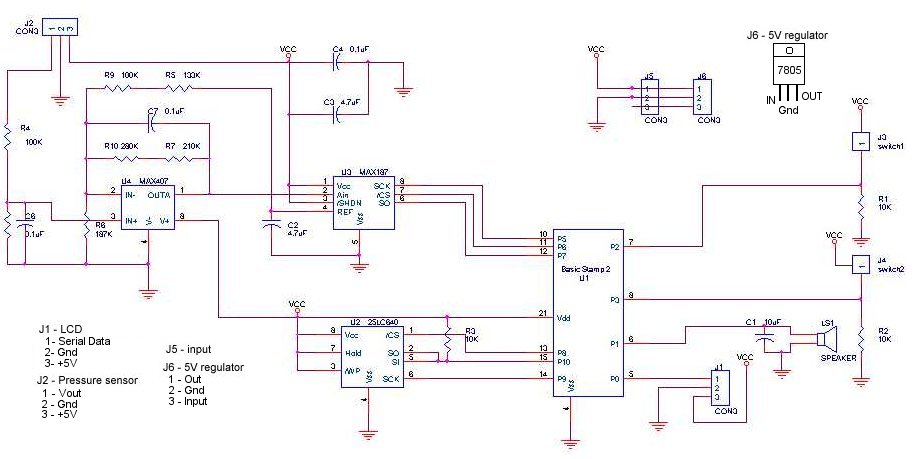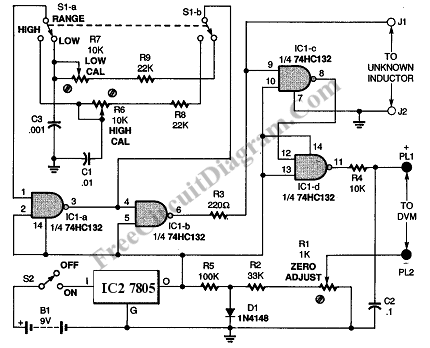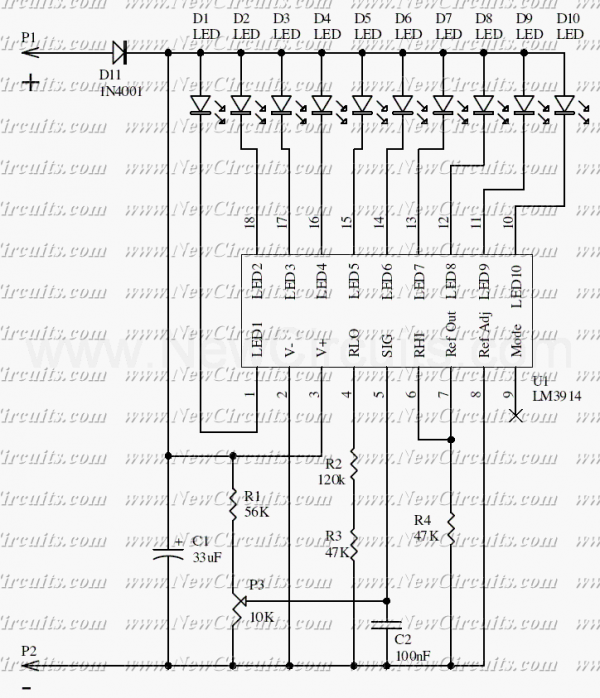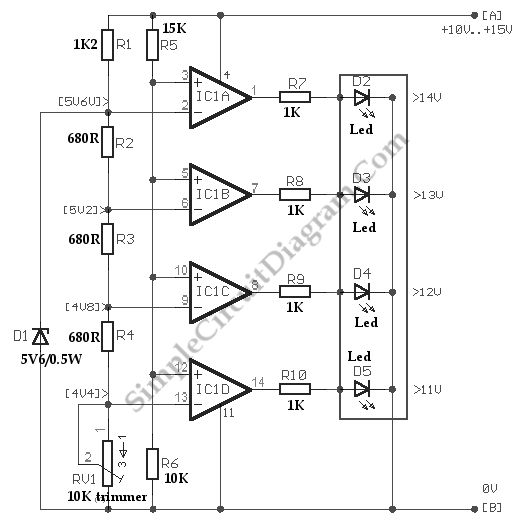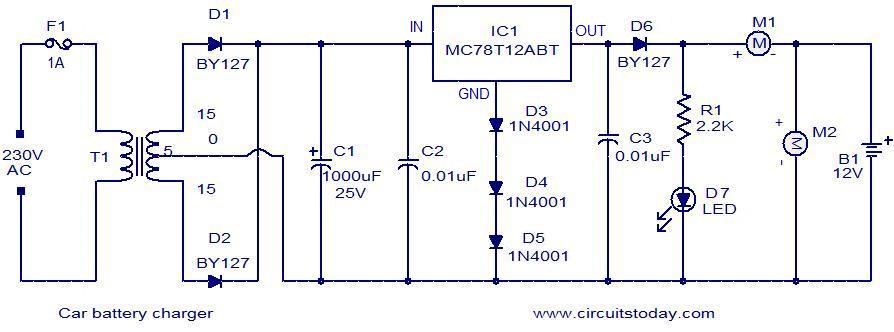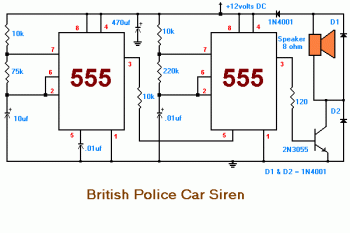
Car Exhaust Meter
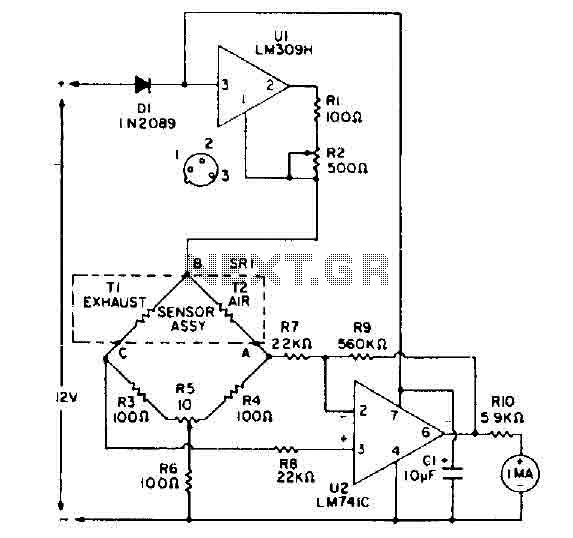
The bridge circuit consists of two resistors (R3 and R4) of 100 ohms each, and two thermistors (T1 and T2). At room temperature, the resistance of both T1 and T2 is approximately 2000 ohms. When exposed to a temperature of 150 °C due to an RNA 10 current, their resistance decreases to 100 ohms. The four components create a bridge circuit where the thermistor T1 is exposed to automobile exhaust, while T2 is placed in a clean air environment. This setup leads to a thermal conduction bridge imbalance, resulting in a voltage difference between points A and C. A differential amplifier (VI) amplifies this voltage difference, providing a current output sufficient to measure the percentage of carbon monoxide (CO) and the air-fuel ratio. To balance the bridge and calibrate the instrument, a control panel with resistor R5 is used. Calibration is performed when both thermistors are in outside air.
The circuit includes additional components such as a 1 µF electrolytic capacitor rated for 25 volts, a silicon diode (D1) or equivalent (IN2069), and an ammeter (Ml) rated at 0.1 RNA. Resistors R1, R3, R4 are rated at 5 ohms with a tolerance of 10% and a power rating of 0.5 watts. The potentiometer (H2) is rated at 10 ohms, while R5 is a 1-ohm potentiometer mounted on the panel. Additional resistors include R8 rated at 22,000 ohms, R9 at 570,000 ohms, and RL0 at 0.900 ohms. The thermistor sensor (SR1) is part number 1648 from Heath Company. Voltage regulation is managed by an LM309H integrated circuit (U1), and an LM741TC operational amplifier (U2) is used in the circuit. Miscellaneous components include a printed circuit board, screws, a cabinet, welding materials, and 10 feet of plastic tubing.
The bridge circuit is designed to detect minute changes in temperature due to variations in CO concentration in the exhaust compared to the clean air environment. The thermistors operate based on their negative temperature coefficient, where their resistance decreases with an increase in temperature. This characteristic allows for precise measurement and differentiation between the thermal responses of T1 and T2, enabling accurate readings of the CO levels. The differential amplifier enhances the voltage difference generated by the imbalance in the bridge circuit, making it possible to read the output more effectively on the control panel. The calibration process ensures that the readings are accurate and reliable, establishing a baseline when both thermistors are subjected to the same environmental conditions. This circuit can serve applications in automotive diagnostics and emissions testing, providing critical data for compliance with environmental regulations.Bridge circuit contains two resistors lOO-ohm (R3 and R4), and two thermistors (Tl and T2). At room temperature, the resistance of T1 and 1'2 is about 2000 ohms. When they are each heated to 150 ° C by an RNA 10 current, the resistance value decreases to 100 ohms. So. the four elements include a bridge circuit. CO is a characteristic that conducts heat from a thermistor at a rate different from that of air. A thermistor, TI, is exposed to automobile exhaust, while the other, 1'2, is isolated in an environment of clean air.
Unlike thermal conduction bridge imbalance. A voltage difference is caused between points A and C. A differential amplifier. VI, amplifies this difference and leads to the counter with a current sufficient to read the percentage of CO and air-fuel ratio. A control panel before the balance, R5, balances the bridge and calibrates the instrument. The calibration is performed when both thermistors are exposed to outside air. Cl O-1 uF. Electrolytic capacitor 25 vall diode Dl-silicon, general purpose, or equivalent IN2069 Ml-0.1 RNA ammeter Rl. R3, R4, IS-ohm Lao Si 10%. watt resistor Tor! All resistors are 10%, though. SO0 watll H2-ohm potentiometer, PC mounting potentiometer R5-la-ohm, mounting panel Tront H7, R8-22, OOO ohms resistance R9-570, OOO-resistance Ohrn TAB BOOKS, INC.
Fig. 7-3 RL0 S-0.900-ohm resistance thermistor sensor-SR1, num ber 100 Part 1648 of the heat mode hKit HERE ) 080. Heath Company Benton Harbor, MI, 49022 lM309H Ul-S-volt regulator integrated cir- cooked U2-lM741TC op amp circuit intergraled Misc.-PC board, screws, cabinet, welding, hard sections, plastic tubing 10 feet, etc.
🔗 External reference
The circuit includes additional components such as a 1 µF electrolytic capacitor rated for 25 volts, a silicon diode (D1) or equivalent (IN2069), and an ammeter (Ml) rated at 0.1 RNA. Resistors R1, R3, R4 are rated at 5 ohms with a tolerance of 10% and a power rating of 0.5 watts. The potentiometer (H2) is rated at 10 ohms, while R5 is a 1-ohm potentiometer mounted on the panel. Additional resistors include R8 rated at 22,000 ohms, R9 at 570,000 ohms, and RL0 at 0.900 ohms. The thermistor sensor (SR1) is part number 1648 from Heath Company. Voltage regulation is managed by an LM309H integrated circuit (U1), and an LM741TC operational amplifier (U2) is used in the circuit. Miscellaneous components include a printed circuit board, screws, a cabinet, welding materials, and 10 feet of plastic tubing.
The bridge circuit is designed to detect minute changes in temperature due to variations in CO concentration in the exhaust compared to the clean air environment. The thermistors operate based on their negative temperature coefficient, where their resistance decreases with an increase in temperature. This characteristic allows for precise measurement and differentiation between the thermal responses of T1 and T2, enabling accurate readings of the CO levels. The differential amplifier enhances the voltage difference generated by the imbalance in the bridge circuit, making it possible to read the output more effectively on the control panel. The calibration process ensures that the readings are accurate and reliable, establishing a baseline when both thermistors are subjected to the same environmental conditions. This circuit can serve applications in automotive diagnostics and emissions testing, providing critical data for compliance with environmental regulations.Bridge circuit contains two resistors lOO-ohm (R3 and R4), and two thermistors (Tl and T2). At room temperature, the resistance of T1 and 1'2 is about 2000 ohms. When they are each heated to 150 ° C by an RNA 10 current, the resistance value decreases to 100 ohms. So. the four elements include a bridge circuit. CO is a characteristic that conducts heat from a thermistor at a rate different from that of air. A thermistor, TI, is exposed to automobile exhaust, while the other, 1'2, is isolated in an environment of clean air.
Unlike thermal conduction bridge imbalance. A voltage difference is caused between points A and C. A differential amplifier. VI, amplifies this difference and leads to the counter with a current sufficient to read the percentage of CO and air-fuel ratio. A control panel before the balance, R5, balances the bridge and calibrates the instrument. The calibration is performed when both thermistors are exposed to outside air. Cl O-1 uF. Electrolytic capacitor 25 vall diode Dl-silicon, general purpose, or equivalent IN2069 Ml-0.1 RNA ammeter Rl. R3, R4, IS-ohm Lao Si 10%. watt resistor Tor! All resistors are 10%, though. SO0 watll H2-ohm potentiometer, PC mounting potentiometer R5-la-ohm, mounting panel Tront H7, R8-22, OOO ohms resistance R9-570, OOO-resistance Ohrn TAB BOOKS, INC.
Fig. 7-3 RL0 S-0.900-ohm resistance thermistor sensor-SR1, num ber 100 Part 1648 of the heat mode hKit HERE ) 080. Heath Company Benton Harbor, MI, 49022 lM309H Ul-S-volt regulator integrated cir- cooked U2-lM741TC op amp circuit intergraled Misc.-PC board, screws, cabinet, welding, hard sections, plastic tubing 10 feet, etc.
🔗 External reference
